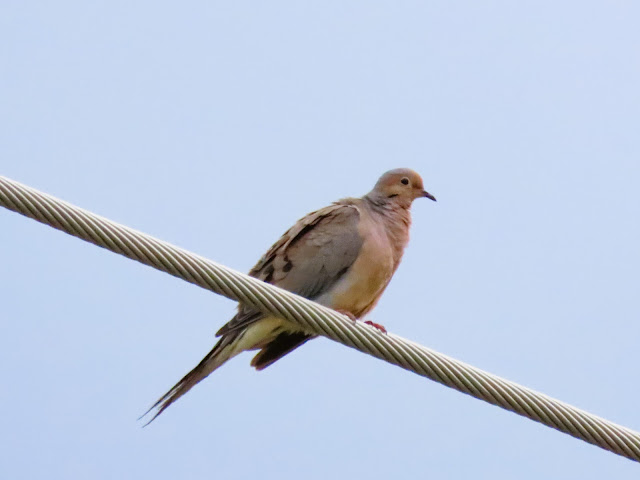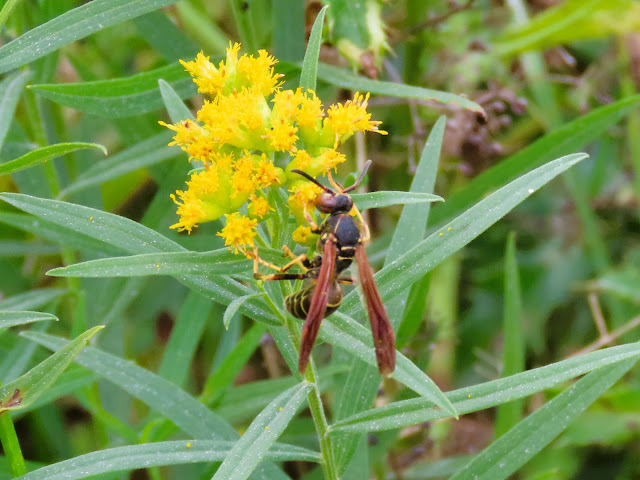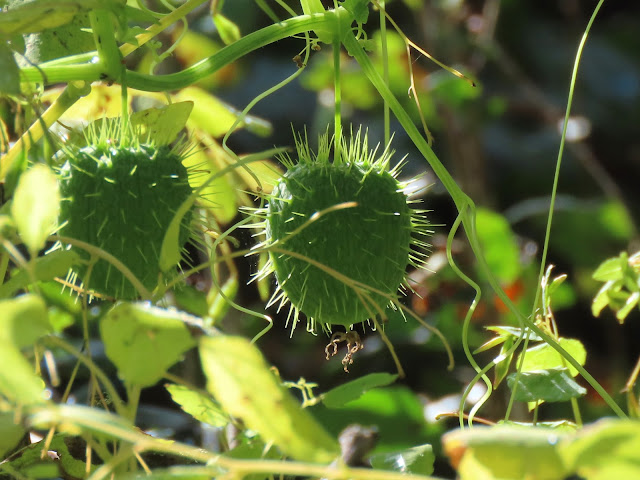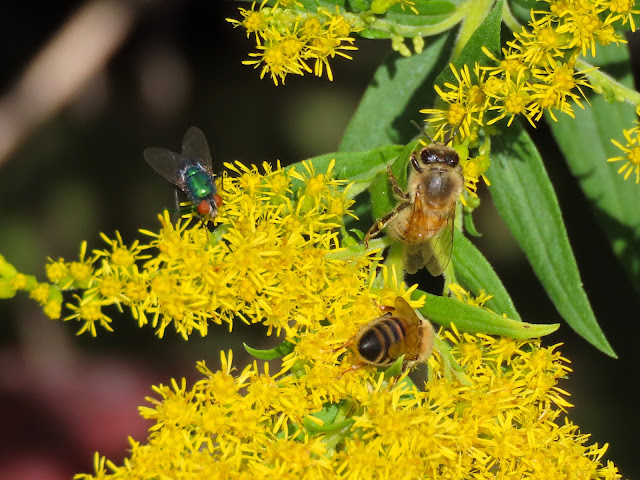17 September, 2023
At home, Waterloo, ON
As we were leaving the house, a Red Admiral (Vanessa atalanta) landed on the Sedum at the corner of the driveway.
An Eastern Carpenter Bee (Xylocapa virginica) found the Sedum equally attractive, no doubt a rich source of pollen and nectar.
17 September, 2023
The country lanes of Waterloo Region
Any birder worth his binoculars will tell you that a sighting of a Merlin (Falco columbarius) is always a cause for celebration.
A Mourning Dove (Zenaida macroura) is far more common, but always worthy of appreciation. It is a consummately beautiful bird.
It is best not to interfere with a Dark Paper Wasp (Polistes fuscatus) as it goes about its business.
Mute Swans (Cygnus olor) render the term "majestic" almost inadequate. They are the very definition of grace and beauty, a fact that is constantly impressed on even the most jaundiced observer.
In the sixth century B.C. in Aesop's Fables he writes:
"A stork that was present at the song of a dying swan told her it was contrary to sing so much out of season, and asked her reason for it. 'Why,' said the swan, 'I am now entering a state where I shall no longer be in danger of either snares, spears, or hunger; and who would not joy at such a deliverance.'"
Perhaps today, when faced with pollution, habitat loss, illegal hunting and lead poisoning, a wise swan might echo the same sentiments.
American Kestrel (Falco sparverius) has become scarce in recent years, so it is always a cause for celebration when one is sighted.
We passed a field that was "filled" with Killdeer (Charadrius vociferus); everywhere we looked there were a two or three scurrying around; doubtless there were more than we observed, concealed in the grass.
Kissing Bridge Trailway, Elmira, ON
There were many Clouded Sulphurs (Colias philodice) flitting from flower to flower, and this one landed long enough for Miriam to take a picture.
Wooly Bear caterpillars, the larvae of Isabella Tiger Moth (Pyrrharctia isabella), are commonly observed in the fall, seeking a well protected place under a thick carpet of leaves, to spend the winter.
A Common Eastern Bumblebee (Bombus impatiens) was exploiting blooms that seem to go on forever in this unusually hot autumn weather.
Jack-in-the-Pulpit (Arisaema triphyllum), that beautiful, beguiling plant of the shady glades of Ontario woodlands in spring, is now bearing fruit.
Greater Burdock (Arctium lappa) could hardly be categorized as everyone's favourite, but it has a certain charm, don't you think?
Meadowhawks are small, red dragonflies seen over most of North America, appearing in late summer and persisting well into the fall. A White-faced Meadowhawk (Sympetrum obtrusum) was a very agreeable addition to our walk.
It is easy to appreciate from the picture below just how much goldenrods (genus Solidago) are used by pollinators.
Select fungi attack the leaves of trees, causing damage in varying degrees, but often creating a quite beautiful pattern in stark contrast to the ravages inflicted on the host. I believe this is Ash Leaf Spot (Mycosphaerella fraxmola).
Bittersweet Nightshade (Solanum dulcamara) bears very attractive berries, but this is another plant where caution is required. The berries are poisonous to humans and livestock.
Nature is wonderful in all its enchanting variety; it's good to remember, however, it was not made with humans in mind. Homo sapiens is the most destructive force of all - and that's a fact we should all remember!














































The flowers you show are so beautiful. I fully understand that the butterfly would land on it. Sedum is a valuable plant to have in autumn. You are lucky to still have butterflies. Snow is reported here tomorrow, and then it remains to be seen what will come. Falcon columbarius is a lovely bird. It must be fun to get a picture of it.
ReplyDeleteHugs and kisses, Marit
Is Jack-in-the-Pulpit also poisonous? I have seen plenty of them lately...love those shots of butterflies and flowers. I was going to pick some stinging nettles this morning to make some flatbread, and since I didn't bring any scissors with me, I had to give it up as stinging nettle rash just ain't fun.
ReplyDeleteI am not sure whether poisonous is the right term but I know that ingesting the leaves can cause blisters and swelling in the mouth, in extreme cases shutting off the air passages, so probably best to leave it alone!
DeleteLove the butterfly image and the Sedum. Yes, I would agree the sighting of a Merlin is always a great sighting. I like the Kestrel, Swans and the Lady beetle too. Pretty flowers , berries and plants. Beautiful nature photos and post. Take care, have a wonderful weekend.
ReplyDeleteA wonderful photos. Lots of interesting things to watch.
ReplyDeleteYou are surely right about the human capacity for destruction. I love that wooly caterpillar. My daughter was always fascinated by spiders and insects and often held them in her little hands, bees, too, but she was never stung. Thanks for sharing all the beauties of nature today, hugs, Valerie xxxxxxx
ReplyDelete...thanks, I plan to keep buzzing along!
ReplyDeleteA wonderful gallery of pictures, and I particularly like the captions, thank you. Sedum are great for insects, usually standing room only here, with bees, wasps, butterflies, beetles, all kinds of visitors.
ReplyDeletebecause I read so many books, i know about the nightshade.. Murder She Wrote. the flowers and berreis and bushes are amazing today and also the visitors. our world is just full of stunning beauty, as your photos show us and I am thinking there are many, my husband being one, that never SEE any of this beauty. I think people who love photography SEE things differently. my favs today are the two prickly plants towards the bottom, now I have forgotten their names. one is the wild cucumber and the one under it.
ReplyDeleteMaybe if more people payed attention to this natural beauty we would do more to protect it.
DeleteThe world of multicolored insects.
ReplyDeleteOur world.
DeleteBonjour mon ami, a lovely set of photos, but the falcon for me is very special. I used to work for a vet in Rhodesian days who was licenced for falconry. I learnt so much from him, and so much respect for Lanners and Peregrines. Amazing birds that always seemed so happy and would fly and swoop for sometimes hours. I do not agree with captured wild birds, but for me it was very educational.
ReplyDeleteBisous, Diane
Gorgeous pictures !
ReplyDeleteWith the subtitles ;)
Have a cozy weekend !
Anna
You had some great finds. I was studying the photo of the merlin because (as I've mentioned) I am not good with hawks, falcons, etc. The kestrel was a great find, and I can tell those, just like ospreys I can also tell. My Merlin app was telingl me a couple of weeks ago I had a red shouldered hawk in the woods near the house, at least by the call. I'm starting to get some of the hawk calls down. Hurrah! It was definitely a lovely September in your area. Happy weekend. hugs-Erika
ReplyDeleteA great variety of beautiful photos.
ReplyDeleteGorgeous captures David! Nice new photo header!
ReplyDeletePrecioso y variado reportaje, me ha encantado y también la foto de cabecera del blog, se os ve muy bien . Justo esta mañana estuve entretenido fotografiando a la Vanessa atalanta. David un fuerte abrazo desde el norte de España, donde el otoño lluvioso acaba de llegar.
ReplyDeleteI was particularly smitten with the first set of photos near your home. The dove reminds me that we haven't been hearing our collared dove lately. We heard it all day every day for a while, then not at all for a while, and then again more frequently when we had a warm, summer-like (for here) spell. Now not at all anymore.
ReplyDeleteIn today's post I admire beautiful flowers and interesting insects. The photos are wonderful as always, you can't take your eyes off them.
ReplyDeleteHave a nice weekend.
These pictures are phenomenal !!
ReplyDeleteSon preciosas tus fotos y todas llenas de vida.
ReplyDeleteFeliz fin de semana.
Cosas maravillosas que si veo por aquí. Y nos alegran al vista. Preciosas David. Gracias
ReplyDeleteQue paséis buen fin de semana.
Un abrazo.
I would not know what to eat and what to touch--so I eat nothing and touch nothing outside in the woods--LOL! Just enjoy the beauty. :)
ReplyDeleteThank you and Miriam (again) for yet another delightful outing.
ReplyDeleteExamples, once again, of Nature at its best. Thank you. :)
ReplyDeleteIn interesting selection of subjects, David, beautifully documented. Some of them are, of course, familiar to me as we have them on this side of the pond, but others seem like very alien forms and are fascinating. Is wild cucumber as edible as it sounds?
ReplyDeleteI'm thinking that I should try growing Goldenrod in our garden - anything to help the invertebrates has to be worth a try.
Best wishes to you and Miriam - - - Richard
That red admiral is a stunner. And you guys are really getting around -- and making that time pay off, too!
ReplyDeleteHi David!
ReplyDeletewhat wonderful photos you have captured, i like the attention to detail on the insects, birds, plants, swans and even mushrooms that you find on your way;also like the reminder that nature was not made with us in mind and that we can be the most destructive force.
I greet you, with affection, and may you have a beautiful weekend walking and enjoying life among swans and roses. Adios, chicos!
We’ve been fortunate enough to see a Merlin for several days along the boardwalk last year. Such beauties! We ‘ve never seen a Kestrel though. Someday…
ReplyDeleteThank you for all the wonderful pictures. I've always liked sedum, and your blooms are lovely.
ReplyDeleteSo many interesting things to observe when one's eyes are open. Lovely images.
ReplyDeleteHow pleasing it is to see the bees...the photos are lovely.
ReplyDeleteWhat a great series of photos David.
ReplyDeleteBeautiful flowers and butterflies, also a beautiful piece of nature from the Kissing Bridge Trailway on September 19.
The mute swans are my favorite this time.
I wish you a good weekend.
Greetings Irma
Hi David - 'Your and Miriam's World' is always wonderful to see - those photos, as the ones selected are quite amazing ... so gorgeous. Michaelmas daisies ... as too the birds - Kestrel and Merlin ... so pleased to see. Miriam's picture of the swans is stunning - so fluffy and comfy looking! Humans don't do help nature much do they ... I wish everyone would remember - cheers and happy weekend - Hilary
ReplyDelete
ReplyDeleteDavid, me encantan las fotos de las aves que siempre encontrais y también, esta vez, de los insectos que habitan en el jardín. Precioso paseo.
Muchos besos.
David, I love the photos of the birds that you always find and also, this time, of the insects that live in the garden. Beautiful walk.
Many kisses.
Hello David,
ReplyDeleteI enjoyed this post, Miriam's nature photos are always a treat. The flowers are lovely, the shot with the Clouded Sulfurs is a favorite along with the Swans. Thank you for linking up and sharing your post. Take care, have a happy weekend. PS, thank you for leaving me a comment.
Hi David.
ReplyDeleteBeautiful series full of the beauty of nature.
Beautiful Butterflies, Insects Flowers and Birds.
Greetings from Patricia.
You make me realize how numerous and beautiful are the species of bees, butterflies, and other insects, which I only look at and do not try to identify. Your photos today are very lovely.
ReplyDeletebest, mae at maefood.blogspot.com
I'm always in awe of swans. They are beautiful beyond words. You really see the complexity of nature, and it's always interesting to go on your walks through your photos.
ReplyDeleteone spring, a kildeer laid eggs in the gravel of the shop yard. we put a flag next to it so we wouldn't run over it when we drove in or get too near when walking. eventually the four little eggs hatched and the babies were so cute. they are capable of running almost as soon as they struggle out of their shell.
ReplyDeleteI've seen so few butterflies this year. too hot maybe.
It looks as if you still have plenty of berries and flowers around too. Here an old wives' tale predicts a really hard winter when lots of berries are to be found.
ReplyDeleteEveryone should grow a Sedum plant in their garden for its pretty colour and the pleasure it brings to insects and butterflies.
You got some nice close ups. Love the wooly bear caterpillar.
ReplyDeleteHow wonderfully you recorded the "stuff" of nature. Love the dragonfly so delicately landed on a leaf and the two swans with poignant words to go along with the photo.
ReplyDeleteBonsoir David.
ReplyDeleteIci côté photos, le faucon et les deux cygnes sont superbes. Côté nature c'est splendide.
Bisous David
Wonderful set of photos, and the header photo is terrific.
ReplyDeleteThe first time I saw a merlin, it had landed in my front evergreen and was feasting on a a small songbird. That made me very unhappy and I would chase it away whenever I saw it. Then my brother told me that they are more prone to eat insects rather than other birds, so I don't get so nearly fussed.
Spring is such a lovely season, but fall/autumn is strikingly beautiful!
The Red Admiral is indeed striking as she perches on the also beautiful sedum ... a lovely way to start a walk. With all of my work with Raptors, I have never seen a Merlin. As I recall they are one of the three Raptors whose coloring between sexes differs ... it would be my guess that this is a female. I love the Mourning Doves, maybe because they mate for life. This year I have seen them gathering in groups as other birds do that are migrating ... I am not sure I have ever seen that before. Your knowledge of insects is amazing. I love finding insects and trying to identify them, but once I do, I find the memory of the names takes flight (has something to do with my age, I assume :). As for the swans. yes they are majestic and beautiful, but until you have been chased by a male protecting his territory, you have no appreciation for their aggressiveness. We used to have to take a push broom with us to the pond to protect ourselves while we fed them. Not my favorite memory of rehab :( to look at Greater Burdock has it's charm, but to try to remove the burrs from your clothing once in contact with it, is a pain. Oh and not to forget the Kestrel, another of the small falcons. They are feisty and beautiful and fun, but yes not seen often anymore. I know of only one place near me where I have spotted them in the wild. Since I moved I am too far away to go there ... sad to say. I have been stung by Nettle ... not a pleasant experience. I now know not to handle it without gloves, as you said. A lovely, always interesting post, David and yes, you are right I haven't found a way to check my spam. I know you gave me directions once, but I wasn't able to find what you were referring to, so no luck. Sorry you are having a problem with my site ... I am guessing you are probably not the only one and I have no way of knowing ... or fixing it. Tech is not my forte' 😒 I know you are enjoying the wonderful fall colors. They seem exceptional this year and I have my camera out constantly snapping pictures. Be well, my friend ...
ReplyDeleteAndrea @ From The Sol
Hello David,
ReplyDeleteThe many insects on the flowers is a nice observation to slow down, I often sit in my flowering meadow in front of my insect hotel and look and listen and be amazed, there is buzzing and buzzing everywhere.. these are moments that are fun and joyful.
Greetings Frank
I thoroughly enjoyed your nature walk observations and the way you've captured the beauty in both the common and the lesser-known creatures and plants around.
ReplyDeleteHello David :=)
ReplyDeleteAnother captivating nature post with beautiful photos, knowledgeable captions, and skillfull and entertaining narration. It is always a joy to visit and see what you encounter on your numerous walks. The breathtaking swan's image with outstanding reflections is one of my favourites, but you found many more delightful species, such as the Ladybugs Meadowhawk dragonfly, Red Admiral and Clouded sulphur. The raptors are new to me, as I have never seen them in Portugal, that is to say they may exist here but I have never seen them. I'm impressed with the colourful Goldenrod and Sedum and the lure they have for pollinators. These plants are not found where I live, but I would like to introduce them into the field near the garage which is kept totally wild to encourage wildlife. Perhaps the nearby nursery might sell the seeds.
As always I send you my best wishes to you both, and a big thank you for all the information gleaned from my visit
Hugs and xxxxxx
Il y'a de très jolies photos, j'aime beaucoup la chenille :D
ReplyDeleteBonne soirée
I guess my favorite is the two swans and their reflection on the water.
ReplyDeleteSuch a lovely variety of beautiful photographs.
ReplyDeleteAll the best Jan
Nature is extraordinary, thank you for this magnificent sharing.
ReplyDeleteI especially loved the first photo, it’s fantastic!
Was für wundervolle Aufnahme, da sieht man mal wieder wie schön die Natur doch ist. LG Romy
ReplyDeleteWow, love it al! But the Wooly Bear caterpillar, the Dove en American Kestrel are very special, Beautiful!!
ReplyDeleteHappy week ahead,
Maria
All kinds of stuff for sure..Gorgeous picture of the Mute Swans..Wonderful series..I'm a bit late commenting..I "unplugged " this past weekend..Have a wonderful week..
ReplyDeleteStinging nettles always remind me of my childhood. They seem to be everywhere in Germany where we call them Brennesseln ("burning nettle"). As a child playing outside every day I had my share of falling into them or just touching them running by etc. and yes, they burn, but thankfully not for too long.
ReplyDeleteDavid, mira en spam mi comentario estará allí. Besos.
ReplyDeleteThe merlin is quite a sight.
ReplyDelete